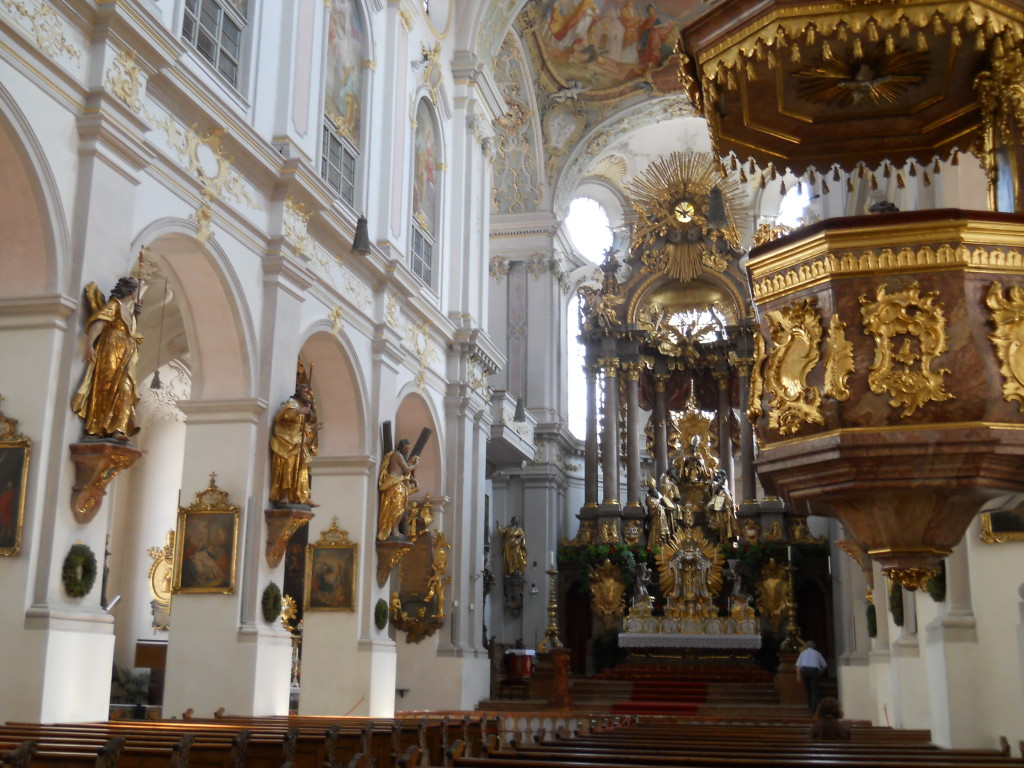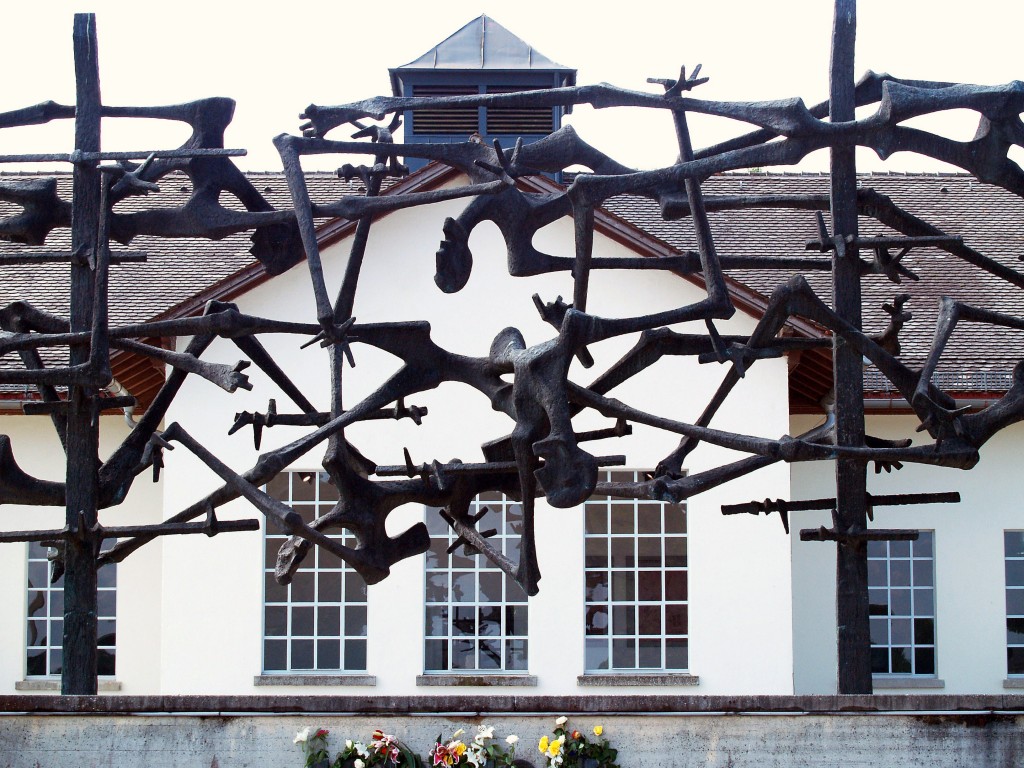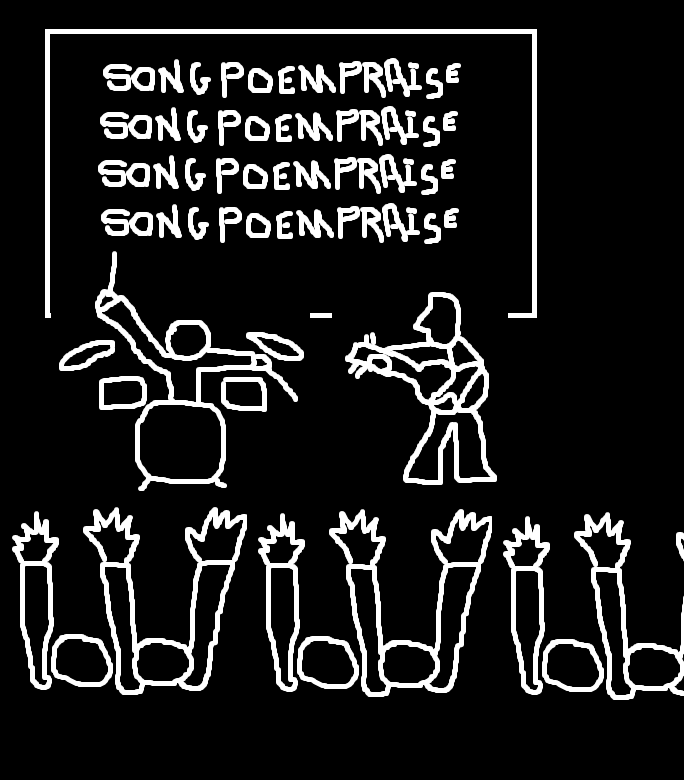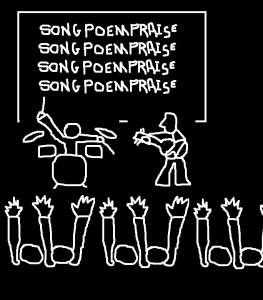St. Vitus has a commanding view of the city of Prague. This Gothic structure is visible from all over the city since it stands within the castle complex situated on top of the highest point in the city.
Getting into the service was a little bit of a trick because church officials stood at the door so as to prevent tourists from entering the church before mass, while at the same time allowing worshipers to pass. We fell into both categories, I suppose, but we entered unimpeded because we approached the door with the confidence of a parishioner. Others more hesitant were refused and had to wait in the long line until noon when the last mass was over and the camera-toting tourists would be let in.
This was the oldest of the cathedrals in which we worshiped on this trip to Europe; parts of the structure date back to the 14th century. The age of the church facilitated a connection to the medieval worshipers who also looked up into these same ceiling vaults.
The whole service was, of course, in Czech, so I had no chance of getting anything out of the sermon. Instead, I studied the stained glass windows that rose far above the old priest who was delivering the homily.
The Windows of St. Vitas
The highest and most central figure was God the father embracing his crucified son. Beneath these figures were smaller haloed saints and kings. All these figures were attended to by angels which were arranged according to their heavenly status. Beneath these were even smaller images of priests and nobles. From my position in the pew, I looked up to them all. The windows reinforce the worshipers’ correct place in the hierarchy of the universe.
This idea–the idea that human beings have different value–is alien to us today. We’ve been taught that “all men [and women] are created equal” and wage war against any notion of the inherent superiority of one individual over another.
Not so in the medieval world. Mankind was seen as higher than the animals and the rest of the created order, and a lower being than the angels. God, as creator and savior, was sovereign above them all. No living human beings could be measured against the greatness of the saints who came before, and no ordinary human could be compared to the greatness of one’s king.
The people who lived in the medieval world, those who built this cathedral, accepted this hierarchical nature of reality. An appropriate response to those above oneself is awe and solemn respect, and this beautiful window would have evoked this response.
The Loss of Hierarchy
We are no longer as capable of experiencing the same sort of awe and solemn respect as our ancestors because there is no other self that is inherently superior to my self.
Living in a medieval society which reflected the hierarchical view of the universe was often a restriction of freedom. But at the same time as they restricted, these orders also gave meaning to life and the idea that some occasions warranted pomp and ceremony. This idea is natural to a people who understand that the universe is full of things greater than themselves.
Although it is hard for us to understand, those honoured through pomp and ceremony in medieval society did not think of themselves in a self-important sort of way; they were living in obedience to the structure which undergirds the universe.
We sometimes struggle to understand the occasions of pomp and ceremony.
The Silliness of Pomp and Ceremony
I recently heard a person who had only recently moved to Canada express incredulity over the reaction of many Canadians (and of course the English) to the recent birth of a son to William and Kate. He couldn’t understand what makes this birth any more special than any other? The same question would likely be asked of royal weddings and coronations.
The overwhelming expression of joy over a royal birth or other special events in the life of the English royalty is a vestigial response to a world that understood the relationship between hierarchy and awe, and the relationship between awe and ceremony. Perhaps, the more peculiar we find this behavior, the flatter our world is.
The Malaise of Modernity
In The Malaise of Modernity, philosopher Charles Taylor suggests there have been significant consequences to this shift from the medieval vertical to the modern horizontal understanding of humanity and society. He says we have lost “a heroic dimension to life. People no longer have a sense of a higher purpose, of something worth dying for” (4). Another consequence is we have become more self-centred “which both flattens and narrows our lives, makes them poorer in meaning, and less concerned with others or society” (4).
We Christians have a problem in that we tacitly embrace the modern, flattened view of the universe, except we retain one aspect of the older view–God retains his position at the top. The rest of the hierarchy has been disassembled, and with it we’ve lost much of our capacity for awe, and pomp and ceremony no longer make much sense. If this is the case, are we not missing something as we approach the throne of God in worship?
The cathedral is a celebration of another view of the universe. It’s not necessarily a true view of the universe, but we’ve got to understand that the modern view isn’t true either.
[click_to_tweet tweet=”The cathedral is a celebration of another view of the universe. It’s not necessarily a true view, but we’ve got to understand that the modern view isn’t true either. #church #worship” quote=”The cathedral is a celebration of another view of the universe. It’s not necessarily a true view, but we’ve got to understand that the modern view isn’t true either. “]
The vast internal spaces overhead and the beautiful stained-glass windows begin to evoke the sense of awe that would have powerfully affected the experience for those who first worshiped in this space. What my experience in the cathedral in Prague did, was give me a hint of my capacity to experience my own smallness and, consequently, awe for He who is so much greater than myself.












